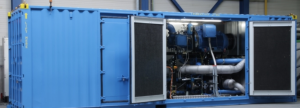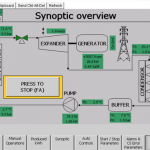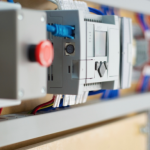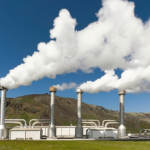
ORC stands for Organic Rankine Cycle. The Rankine Cycle also known as the steam cycle was firstly described by William John Macquorn Rankine in 1859. An ORC installation is based on the basic principle of the Rankine Cycle, substituting an organic fluid for water.
ORC machines produce electricity out of waste heat. For some applications such as floor heating, swimming pool applications, glass house heating our machines can also convert waste heat to useful heat besides making electricity.
Our ORC machines are emission-free and make ten times more electricity compared to what they consume internally.
Several our Clients use our ORC machines’ electricity for internal consumption, meaning less electricity has to be bought from the grid, and neither distribution costs, nor taxes need to be paid for.
Advantages:
- Electricity from (free) waste heat
- No CO2 emissions, no fuel consumption
- Production costs for electricity are competitive, making the technology profitable even if the cost of electricity fell from today’s prices
- Subsidies may apply depending on the application and local in country policies
- ORC machines cover temperature ranges on the hot side between 80 to 150 degrees Celsius. These machines are easy to use in different industrial environments.
Waste heat from industrial processes and residual heat from heat and power production or waste incineration, represent a significant energy resource which is widely overlooked today. The energy losses don’t just reduce system performance. Actually cooling this residual heat consumes additional primary electric power!
Our ORC is a stand-alone machine that transforms such waste heat and costs for cooling into emission-free power and new revenues.
Our ORC machines are equipped with best-in-class industrial grade components together with sophisticated PLC controls and remote operation capabilities. Most of our ORC are delivered in a containerized solution and hence are simple to install.This approach results in high operational reliability and low maintenance costs.
Gallery
Products
ORC 1000
The ORC-1000 machine absorbs up to 1000 kW (3.4 MMBTU/h) of heat in a temperature range between 80°C and 150°C (176 F – 302 F). The ORC units are heat powered by hot water, thermal oil or low pressure steam.
ORC-4000
The ORC-4000 machine absorbs up to 4,000 kW (13.65 MMBTU/h) thermal heat in a temperature range between 80°C and 150°C (176 F – 302 F). The ORC units are heat powered by hot water, thermal oil or low pressure steam.
Applications
Industrial Waste Heat
Many industrial sites have heat excess or waste heat to be cooled down. Industrial high-temperature processes use heat exchangers and coolers before process water can be recycled or discharged. Cooling is required for legal or technical reasons. This brings significant energy losses and high costs. With ORC a portion of this process heat can be transformed into new power production, whilst at the same time decreasing cooling costs. Some examples are described here.
FLUE GAS HEAT
Multiple processes produce exhaust gases at high temperatures. These applications require either quenching, air injection or other technologies to cool the flue gas. By installing a heat exchanger with a water-, steam- or thermal oil circuit, the remaining heat in the flue gas is recuperated. The ORC can be introduced to this secondary circuit to recover the heat into electricity.
STEEL FACTORIES
The walking beam ovens in a steel factory have a cooling circuit at typical temperatures of 74°C to 83°C. This circuit is cooled by an adiabatic cooler, dry cooler or cooling tower. By introducing an ORC to the circuit, the remaining heat is converted to electricity and the consumed power and/or water of the cooler or cooling tower is eliminated.
HEATING OR COOLING PROCESSES
Numerous processes require heating up (heat-treatments, pasteurization,…) or cooling down (exothermal processes,…). These procedures are present in many industrial applications in food industry, chemical industry, etc. Also for these processes, E-RATIONAL ORCs are a solution to eliminate costs for waste heat removal and to recover thermal energy.
To recover waste heat in industrial applications, a water-, steam- or thermal oil circuit is required. Both centralized or decentralized integration of multiple units is possible. Contact our representatives to find out the most suitable solution
Combined Heat & Power
Cogeneration is a process that generates both electricity and heat at the same time. The benefit of this process is that the overall efficiency (heat AND power) is maximized therefore optimizing the fuel consumption..
GENERATOR SETS & COMBUSTION ENGINES
The CHP-principle is viable for combustion engines fueled by natural gas, biogas, diesel or vegetable oil. ORC can increase the electrical efficiency and therefore the power-to-heat ratio of such micro-generation plants by recuperating the heat released by the engines. Diesel of (natural- or bio-) gas engines convert about 40% of the available fuel energy to usable power. The remaining 60% is lost as heat and in most cases can be considered as waste. ORC can recover this low grade heat, derived from jacket cooling and/or exhaust gas cooling and convert it into cost effective electricity. By introducing the ORC, there is an overall gain of 3-8% in electrical efficiency which is the result of the extra electricity produced by the ORC. Basically , for the same amount of fuel consumed (by the gen-set or the engine) the amount of produced electricity is 3-8% higher for the complete setup. Our containerized or skid-mounted ORC solutions are easily integrated as a retrofit to existing cooling systems valorizing the waste heat from jacket cooling.
BIOMASS POWER GENERATION
ORC can also be used for primary power generation by connecting the machine directly to biomass-fueled boilers. In most cases this can be considered a cogeneration project, generating both Heat and Power. Using biomass makes the produced electricity (and heat) 100% green. Slightly increasing the working temperature of the ORC’s cooling water (while accepting a small decrease in power production) can make the cooling water of the ORC useful for heating applications, such as underfloor heating, heating of green houses or other applications that require a specific temperature. Such a configuration is a high performant set-up because all energy captured by the ORC is either converted to electricity or applied useful for heating purposes.
District Heating
These days, district heating networks are common in Germany and Scandinavia. Such heating networks distribute hot water to households and offices. The heat sources for the hot water are industrial processes and incinerators or geothermal wells.
Due to the changes of the ambient conditions between different seasons (winter vs. summer), the heat demand of the consumers changes proportional, resulting in a heat excess on the net. The excess heat needs to be cooled as to keep the factory-to-district loop stable, which represents an extra electrical cost.
By installing an ORC, the excess heat can be converted to emission free new electricity, increasing the overall efficiency of the system, minimizing the cooling cost and optimizing the use of the available thermal power. As such, the ORC can be the “handshake” between industry and energy utilities, and at the same time, support our future economic and environmental values.
Geothermal Heat
Also for low temperature geothermal heat, the ORC can offer a viable solution. Underground temperatures are less influenced by the seasonal changes because of the insulation properties of the ground. In case of geothermal heat sources, temperatures of the aquifer at a certain depth remain almost constant all year. Currently, BEP Europe supports several clients in the south of Japan for geothermal applications.
PRIMARY CIRCUIT
A geothermal system typically consists of a piping network to pump up the brine from the geothermal wells. After passing a heat exchanger for recovery of the geothermal heat, the brine is reinjected into the same aquifer in order to create a closed loop circuit.. The intermediate heat exchanger insures robustness against the salts and solids of the brine.
SECONDARY CIRCUIT
Transferring the heat of the geothermal brine to a secondary water loop makes sure the geothermal heat is applicable for multiple purposes. In this case of geothermal heat at lower grade temperatures, the RC will recover the thermal energy and convert it to electricity. The constant and stable presence of the geothermal aquifer assures maximized operability of the ORC during the year.
OPTIONAL CIRCUIT
Even in this configuration it is possible to deliver the remaining heat in the cooling circuit of the ORC to heat consumers such as glasshouses and households. Such solutions are integrated in our Japanese projects.
Want to know more? Download product leaflet in English or Japanese or send us an email.



















